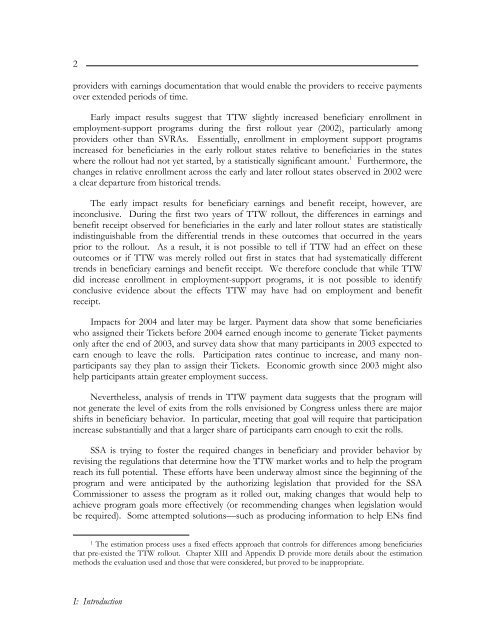Evaluation of the Ticket To Work Program - Mathematica Policy ...
Evaluation of the Ticket To Work Program - Mathematica Policy ...
Evaluation of the Ticket To Work Program - Mathematica Policy ...
You also want an ePaper? Increase the reach of your titles
YUMPU automatically turns print PDFs into web optimized ePapers that Google loves.
2<br />
providers with earnings documentation that would enable <strong>the</strong> providers to receive payments<br />
over extended periods <strong>of</strong> time.<br />
Early impact results suggest that TTW slightly increased beneficiary enrollment in<br />
employment-support programs during <strong>the</strong> first rollout year (2002), particularly among<br />
providers o<strong>the</strong>r than SVRAs. Essentially, enrollment in employment support programs<br />
increased for beneficiaries in <strong>the</strong> early rollout states relative to beneficiaries in <strong>the</strong> states<br />
where <strong>the</strong> rollout had not yet started, by a statistically significant amount. 1 Fur<strong>the</strong>rmore, <strong>the</strong><br />
changes in relative enrollment across <strong>the</strong> early and later rollout states observed in 2002 were<br />
a clear departure from historical trends.<br />
The early impact results for beneficiary earnings and benefit receipt, however, are<br />
inconclusive. During <strong>the</strong> first two years <strong>of</strong> TTW rollout, <strong>the</strong> differences in earnings and<br />
benefit receipt observed for beneficiaries in <strong>the</strong> early and later rollout states are statistically<br />
indistinguishable from <strong>the</strong> differential trends in <strong>the</strong>se outcomes that occurred in <strong>the</strong> years<br />
prior to <strong>the</strong> rollout. As a result, it is not possible to tell if TTW had an effect on <strong>the</strong>se<br />
outcomes or if TTW was merely rolled out first in states that had systematically different<br />
trends in beneficiary earnings and benefit receipt. We <strong>the</strong>refore conclude that while TTW<br />
did increase enrollment in employment-support programs, it is not possible to identify<br />
conclusive evidence about <strong>the</strong> effects TTW may have had on employment and benefit<br />
receipt.<br />
Impacts for 2004 and later may be larger. Payment data show that some beneficiaries<br />
who assigned <strong>the</strong>ir <strong>Ticket</strong>s before 2004 earned enough income to generate <strong>Ticket</strong> payments<br />
only after <strong>the</strong> end <strong>of</strong> 2003, and survey data show that many participants in 2003 expected to<br />
earn enough to leave <strong>the</strong> rolls. Participation rates continue to increase, and many nonparticipants<br />
say <strong>the</strong>y plan to assign <strong>the</strong>ir <strong>Ticket</strong>s. Economic growth since 2003 might also<br />
help participants attain greater employment success.<br />
Never<strong>the</strong>less, analysis <strong>of</strong> trends in TTW payment data suggests that <strong>the</strong> program will<br />
not generate <strong>the</strong> level <strong>of</strong> exits from <strong>the</strong> rolls envisioned by Congress unless <strong>the</strong>re are major<br />
shifts in beneficiary behavior. In particular, meeting that goal will require that participation<br />
increase substantially and that a larger share <strong>of</strong> participants earn enough to exit <strong>the</strong> rolls.<br />
SSA is trying to foster <strong>the</strong> required changes in beneficiary and provider behavior by<br />
revising <strong>the</strong> regulations that determine how <strong>the</strong> TTW market works and to help <strong>the</strong> program<br />
reach its full potential. These efforts have been underway almost since <strong>the</strong> beginning <strong>of</strong> <strong>the</strong><br />
program and were anticipated by <strong>the</strong> authorizing legislation that provided for <strong>the</strong> SSA<br />
Commissioner to assess <strong>the</strong> program as it rolled out, making changes that would help to<br />
achieve program goals more effectively (or recommending changes when legislation would<br />
be required). Some attempted solutions—such as producing information to help ENs find<br />
1 The estimation process uses a fixed effects approach that controls for differences among beneficiaries<br />
that pre-existed <strong>the</strong> TTW rollout. Chapter XIII and Appendix D provide more details about <strong>the</strong> estimation<br />
methods <strong>the</strong> evaluation used and those that were considered, but proved to be inappropriate.<br />
I: Introduction
















